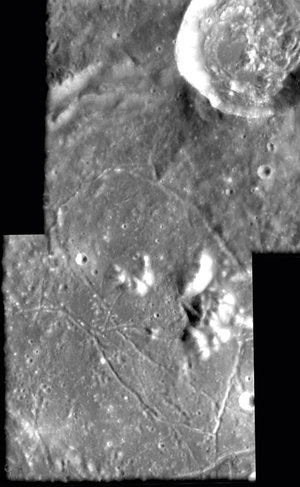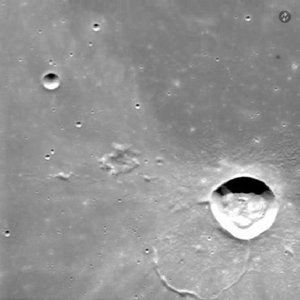ESA 'birthday card' of Apollo 11 landing site
This image, taken by the advanced Moon Imaging Experiment (AMIE) on board ESA’s SMART-1 spacecraft, shows the Apollo 11 landing site in the Mare Tranquillitatis on the Moon.
SMART-1's AMIE camera obtained this image on 5 February 2006 from a distance of 1764 kilometres from the surface, with a ground resolution of 159 metres per pixel. The imaged area is centred at a longitude of 23.9º East close to the Moon equator, at 1.7º latitude. This image is a mosaic of several filter images of AMIE, the boundaries of which can be seen by thin horizontal lines (north is up).
SMART-1, the first European mission to the Moon, concluded its adventure in the early morning of 3 September 2006 when it impacted on the lunar surface in the 'Lake of Excellence'.
The area in the image is close to crater Moltke (just out of view) in the Mare Tranquilitatis. The arrow shows the landing site of Apollo 11, where the first men from Earth set foot on another object in our Solar System on 20 July 1969. The two prominent craters nearby are named after two of the Apollo 11 astronauts. The first man on the Moon, Neil Armstrong, has a crater named after him outside the field of this image.
As can be seen from the image, the area which was selected for the first landing has a fairly featureless, on a large scale smooth surface. This was done on purpose to make the landing easier.
The landing sites of the Apollo missions are important calibration targets for lunar remote-sensing missions, as these are the places from where material was brought back to Earth and analysed in detail. The age of the rocks returned with Apollo can be determined with radioisotopic dating methods to very high accuracy and give 'reference points' to remote sensing instruments.
"From SMART-1 observations of previous landing sites we can compare remote observations to the ground truth, and expand from local to global views of the Moon, and we can better define potential sites for future landers," said Bernard Foing, ESA’s SMART-1 Project Scientist. The SMART-1 team is contributing its experience and data set for potential future missions of lunar orbiters and landers.
For more information
Bernard H. Foing, ESA SMART-1 Project Scientist
Email: bernard.foing @ esa.int















 Germany
Germany
 Austria
Austria
 Belgium
Belgium
 Denmark
Denmark
 Spain
Spain
 Estonia
Estonia
 Finland
Finland
 France
France
 Greece
Greece
 Hungary
Hungary
 Ireland
Ireland
 Italy
Italy
 Luxembourg
Luxembourg
 Norway
Norway
 The Netherlands
The Netherlands
 Poland
Poland
 Portugal
Portugal
 Czechia
Czechia
 Romania
Romania
 United Kingdom
United Kingdom
 Slovenia
Slovenia
 Sweden
Sweden
 Switzerland
Switzerland












































